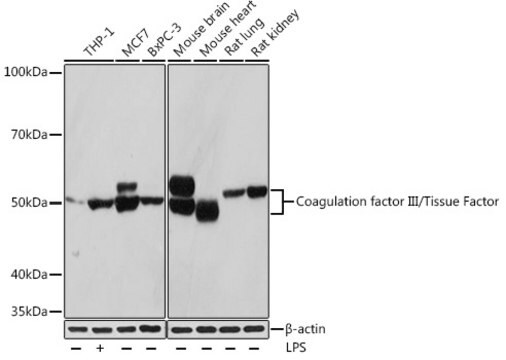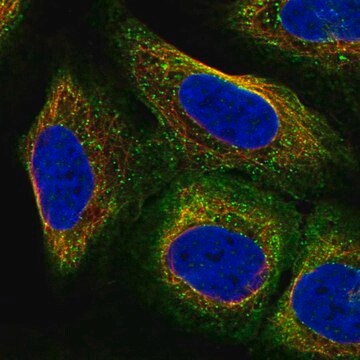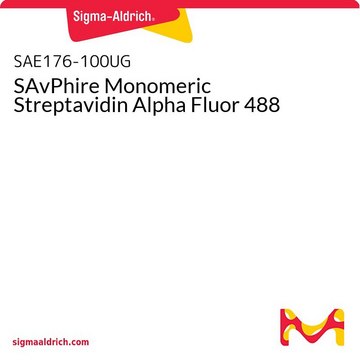MABF3203
Anti-Tissue Factor/CD142 Antibody, clone HTF-1
Synonym(e):
Coagulation factor III, HTF1-7B8, TF, Thromboplastin
About This Item
Empfohlene Produkte
Biologische Quelle
mouse
Qualitätsniveau
Antikörperform
purified antibody
Antikörper-Produkttyp
primary antibodies
Klon
HTF-1, monoclonal
Mol-Gew.
calculated mol wt 33 kDa
observed mol wt ~42-48 kDa
Aufgereinigt durch
using protein G
Speziesreaktivität
human, bovine
Verpackung
antibody small pack of 100
Methode(n)
ELISA: suitable
dot blot: suitable
flow cytometry: suitable
immunohistochemistry: suitable
inhibition assay: suitable
western blot: suitable
Isotyp
IgG1κ
Epitopsequenz
Unknown
Protein-ID-Hinterlegungsnummer
UniProt-Hinterlegungsnummer
Lagertemp.
-10 to -25°C
Angaben zum Gen
human ... F3(2152)
Spezifität
Immunogen
Anwendung
Tissue factor: Identification and characterization of cell types in human placentae. (Faulk, W.P., C.A. Labarrere, and S.D. Carson. (1990). Blood 76:86-96).
Immunofluorescent studies of tissue factor on U87MG cells: Evidence for non-uniform distribution. Carson, S.D., and S.J. Pirruccello. (1993). Blood Coagulation and Fibrinolysis 4:911-920).
Flow Cytometry
Tissue factor antigen and activity are not expressed on the surface of intact cells isolated from an acute promyelocytic leukemia patient. (Carson, S.D., S.J. Pirruccello, and W.D. Haire. (1990). Thrombos. Res. 59:159-170).
Immunohistochemistry
Participation of cell-mediated immunity in the deposition of fibrin in glomerulonephritis. (Neale, T.J., P.G. Tipping, S.D. Carson, and S.R. Holdsworth. (1988). Lancet, No. 8606, 2:421-424).
Tissue factor antigen in senile plaques of Alzheimer′s disease. (McComb, R.D., K.A. Miller, and S.D. Carson. (1991). Am. J. Path. 139:491-494).
Immunoaffinity purification of the tissue factor protein
An inhibitory monoclonal antibody against human tissue factor. (Carson, S.D., S.E. Ross, R. Bach, and A. Guha. (1987). Blood 70:490-493).
Evaluated by Western Blotting in A-431cell lysate.
Western Blotting Analysis: A 1:500 dilution of this antibody detected Tissue Factor/CD142 in A-431 cell lysate.
Tested Applications
ELISA Analysis: A representative lot detected Tissue Factor/CD142 in ELISA applications (Carson, S.D., et al. (1987). Blood. 70(2):490-3).
Western Blotting Analysis: A representative lot detected Tissue Factor/CD142 in Western Blotting applications (Carson, S.D., et al. (1987). Blood. 70(2):490-3). .
Dot Blot: A representative lot detected Tissue Factor/CD142 in Dot Blot applications (Carson, S.D., et al. (1987). Blood. 70(2):490-3).
Inhibition Assay: A representative lot detected Tissue Factor/CD142 in Inhibition applications (Carson, S.D., et al. (1987). Blood. 70(2):490-3).
Note: Actual optimal working dilutions must be determined by end user as specimens, and experimental conditions may vary with the end user.
Zielbeschreibung
Physikalische Form
Rekonstituierung
Lagerung und Haltbarkeit
Sonstige Hinweise
Haftungsausschluss
Sie haben nicht das passende Produkt gefunden?
Probieren Sie unser Produkt-Auswahlhilfe. aus.
Lagerklassenschlüssel
12 - Non Combustible Liquids
WGK
WGK 2
Flammpunkt (°F)
Not applicable
Flammpunkt (°C)
Not applicable
Analysenzertifikate (COA)
Suchen Sie nach Analysenzertifikate (COA), indem Sie die Lot-/Chargennummer des Produkts eingeben. Lot- und Chargennummern sind auf dem Produktetikett hinter den Wörtern ‘Lot’ oder ‘Batch’ (Lot oder Charge) zu finden.
Besitzen Sie dieses Produkt bereits?
In der Dokumentenbibliothek finden Sie die Dokumentation zu den Produkten, die Sie kürzlich erworben haben.
Unser Team von Wissenschaftlern verfügt über Erfahrung in allen Forschungsbereichen einschließlich Life Science, Materialwissenschaften, chemischer Synthese, Chromatographie, Analytik und vielen mehr..
Setzen Sie sich mit dem technischen Dienst in Verbindung.







